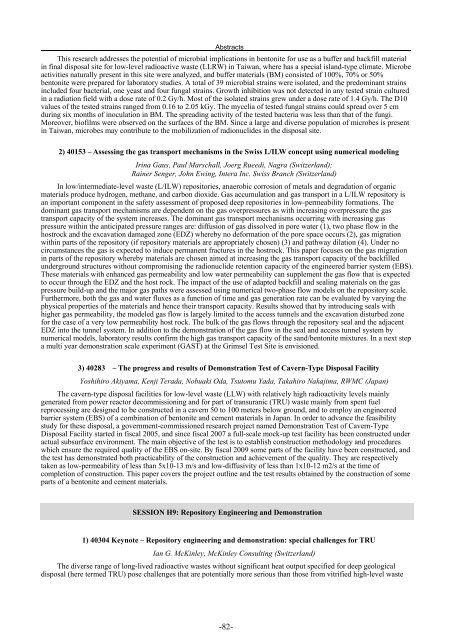ASME Message
ASME Message
ASME Message
You also want an ePaper? Increase the reach of your titles
YUMPU automatically turns print PDFs into web optimized ePapers that Google loves.
Abstracts<br />
This research addresses the potential of microbial implications in bentonite for use as a buffer and backfill material<br />
in final disposal site for low-level radioactive waste (LLRW) in Taiwan, where has a special island-type climate. Microbe<br />
activities naturally present in this site were analyzed, and buffer materials (BM) consisted of 100%, 70% or 50%<br />
bentonite were prepared for laboratory studies. A total of 39 microbial strains were isolated, and the predominant strains<br />
included four bacterial, one yeast and four fungal strains. Growth inhibition was not detected in any tested strain cultured<br />
in a radiation field with a dose rate of 0.2 Gy/h. Most of the isolated strains grew under a dose rate of 1.4 Gy/h. The D10<br />
values of the tested strains ranged from 0.16 to 2.05 kGy. The mycelia of tested fungal strains could spread over 5 cm<br />
during six months of inoculation in BM. The spreading activity of the tested bacteria was less than that of the fungi.<br />
Moreover, biofilms were observed on the surfaces of the BM. Since a large and diverse population of microbes is present<br />
in Taiwan, microbes may contribute to the mobilization of radionuclides in the disposal site.<br />
2) 40153 – Assessing the gas transport mechanisms in the Swiss L/ILW concept using numerical modeling<br />
Irina Gaus, Paul Marschall, Joerg Rueedi, Nagra (Switzerland);<br />
Rainer Senger, John Ewing, Intera Inc. Swiss Branch (Switzerland)<br />
In low/intermediate-level waste (L/ILW) repositories, anaerobic corrosion of metals and degradation of organic<br />
materials produce hydrogen, methane, and carbon dioxide. Gas accumulation and gas transport in a L/ILW repository is<br />
an important component in the safety assessment of proposed deep repositories in low-permeability formations. The<br />
dominant gas transport mechanisms are dependent on the gas overpressures as with increasing overpressure the gas<br />
transport capacity of the system increases. The dominant gas transport mechanisms occurring with increasing gas<br />
pressure within the anticipated pressure ranges are: diffusion of gas dissolved in pore water (1), two phase flow in the<br />
hostrock and the excavation damaged zone (EDZ) whereby no deformation of the pore space occurs (2), gas migration<br />
within parts of the repository (if repository materials are appropriately chosen) (3) and pathway dilation (4). Under no<br />
circumstances the gas is expected to induce permanent fractures in the hostrock. This paper focuses on the gas migration<br />
in parts of the repository whereby materials are chosen aimed at increasing the gas transport capacity of the backfilled<br />
underground structures without compromising the radionuclide retention capacity of the engineered barrier system (EBS).<br />
These materials with enhanced gas permeability and low water permeability can supplement the gas flow that is expected<br />
to occur through the EDZ and the host rock. The impact of the use of adapted backfill and sealing materials on the gas<br />
pressure build-up and the major gas paths were assessed using numerical two-phase flow models on the repository scale.<br />
Furthermore, both the gas and water fluxes as a function of time and gas generation rate can be evaluated by varying the<br />
physical properties of the materials and hence their transport capacity. Results showed that by introducing seals with<br />
higher gas permeability, the modeled gas flow is largely limited to the access tunnels and the excavation disturbed zone<br />
for the case of a very low permeability host rock. The bulk of the gas flows through the repository seal and the adjacent<br />
EDZ into the tunnel system. In addition to the demonstration of the gas flow in the seal and access tunnel system by<br />
numerical models, laboratory results confirm the high gas transport capacity of the sand/bentonite mixtures. In a next step<br />
a multi year demonstration scale experiment (GAST) at the Grimsel Test Site is envisioned.<br />
3) 40283 – The progress and results of Demonstration Test of Cavern-Type Disposal Facility<br />
Yoshihiro Akiyama, Kenji Terada, Nobuaki Oda, Tsutomu Yada, Takahiro Nakajima, RWMC (Japan)<br />
The cavern-type disposal facilities for low-level waste (LLW) with relatively high radioactivity levels mainly<br />
generated from power reactor decommissioning and for part of transuranic (TRU) waste mainly from spent fuel<br />
reprocessing are designed to be constructed in a cavern 50 to 100 meters below ground, and to employ an engineered<br />
barrier system (EBS) of a combination of bentonite and cement materials in Japan. In order to advance the feasibility<br />
study for these disposal, a government-commissioned research project named Demonstration Test of Cavern-Type<br />
Disposal Facility started in fiscal 2005, and since fiscal 2007 a full-scale mock-up test facility has been constructed under<br />
actual subsurface environment. The main objective of the test is to establish construction methodology and procedures<br />
which ensure the required quality of the EBS on-site. By fiscal 2009 some parts of the facility have been constructed, and<br />
the test has demonstrated both practicability of the construction and achievement of the quality. They are respectively<br />
taken as low-permeability of less than 5x10-13 m/s and low-diffusivity of less than 1x10-12 m2/s at the time of<br />
completion of construction. This paper covers the project outline and the test results obtained by the construction of some<br />
parts of a bentonite and cement materials.<br />
SESSION H9: Repository Engineering and Demonstration<br />
1) 40304 Keynote – Repository engineering and demonstration: special challenges for TRU<br />
Ian G. McKinley, McKinley Consulting (Switzerland)<br />
The diverse range of long-lived radioactive wastes without significant heat output specified for deep geological<br />
disposal (here termed TRU) pose challenges that are potentially more serious than those from vitrified high-level waste<br />
-82-


